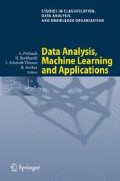Abstract
With increasing duration of a relationship the probability that customers experience specifically negative interaction episodes but also very positive interaction episodes increases. A key question that has not been investigated in the literature concerns the impact of these extreme interaction experiences, referred to as Critical Incidents (CIs) on the quality and strength of consumer-firm relationships. In a sample of customers in a service setting we first demonstrate that indeed the number of negative (positive) CIs possess a negative (positive) and asymmetric impact on measures of relationship quality (satisfaction, trust) and measure of relationship strength (loyalty). Second using a MIMIC approach we further shed light on the question which particular incidents are really critical for a customer firm relationship and which have to be prevented with priority.
Access this chapter
Tax calculation will be finalised at checkout
Purchases are for personal use only
Preview
Unable to display preview. Download preview PDF.
References
BARON, R. and KENNY, D. (1986): The Moderator-Mediator Variable Distinction in Social Psychological Research: Conceptual, Strategic and Statistical Considerations. Journal of Personality and Social Psychology, 51 (6), 1173-1182.
BAUMEISTER, R. F., BRATSLAVSKY, E., FUNKENAUER, C., and VOHS, K. D. (2001): Bad is Stronger than good. Review of General Psychology, 5 (4), 323-370.
BITNER, M. J., BOOMS, B. H., and TETREAULT, M. S. (1990): The Service Encounter -Diagnosing Favorable and Unfavorable Incidents. Journal of Marketing, 54(1), 71-84.
BOLLEN, K. A. (1989): Structural Equations with Latent Variables. New York: Wiley.
EDVARDSSON, B. (1992). Service Breakdowns: A Study of Critical Incidents in an Airline. International Journal of Service Industry Management, 3(4), 17-29.
EDVARDSSON, B., and STRANDVIK, T. (2000): Is a Critical Incident Critical for a Cus-tomer Relationship? Managing Service Quality, 10(2), 82-91.
EICH E, MACAULAY D., and RYAN L. (1994): Mood Dependent Memory for Events of the Personal Past. Journal of Experimental Psychology - General, 123 (2), 201-215.
FISKE, S. (1980): Attention and Weight in Person Perception - the Impact of Negative and Extreme Behaviour. Journal of Personality and Social Psychology, 38 (6), 889-906.
FORGAS, J. P. (1995): Mood and Judgment: The Affect Infusion Model (AIM). Psychological Bulletin, 117 (1), 39-66.
FORNELL, C., JOHNSON, M. D., ANDERSON, E. W., CHA, J., and BRYANT, B. E. (1996): The American Customer Satisfaction Index: Nature, Purposes, and Findings. Journal of Marketing, 60 (October), 7-18.
GEYSKENS, I., STEENKAMP, J-B. E. M., and KUMAR, N. (1999): A Meta-Analysis of Sat-isfaction in Marketing Channel Relationships. Journal of Marketing Research, 36 (May), 223-238.
GREMLER, D. (2004): The Critical Incident Technique in Service Research. Journal of Ser-vice Research, 7(1), 65-89.
JÖRESKOG, K. and SÖRBOM, D. (2001): LISREL 8: User’s Reference Guide. Chicago: Scientific Software International.
KAHNEMAN, D. and TVERSKY, A. (1979): Prospect Theory - Analysis of Decision under Risk. Econometrica, 47(2), 263-291.
MORGAN, R. M. and HUNT, S. D. (1994): The commitment-trust theory of relationship marketing. Journal of Marketing, 58(3), 20-38.
ODEKERKEN-SCHRÖDER, G., van BIRGELEN, M., LEMMINK, J., de RUYTER, K., and WETZELS, M. (2000): Moments of Sorrow and Joy: An Empirical Assessment of the Complementary Value of Critical Incidents in Understanding Customer Service Evalua-tions. European Journal of Marketing, 34(1/2), 107-125.
ROOS, I. (2002): Methods of Investigating Critical Incidents - A Comparative Review. Journal of Service Research, 4 (3), 193-204.
SINGH, J. and SIRDESHMUKH, D. (2000): Agency and Trust Mechanisms in Consumer satisfaction and loyalty judgments. Journal of the Academy of the Marketing Science, 28 (1),150-167.
STAUSS, B. and HENTSCHEL, B. (1992): Attribute-based versus Incident-based Measure-ment of Service Quality: Results of an Empirical Study in the German Car Service In-dustry. In: P. Kunst and J. Lemmink, (Eds.), Quality Management in Services (59-78).
STAUSS, B. and WEINLICH, B. (1997): Process-oriented Measurement of Service Quality - Applying the Sequential Incident Technique. European Journal of Marketing, 31 (1), 33-55.
SZYMANSKI, D. M. and HENARD, D. H. (2001): Customer Satisfaction: A Meta-Analysis of the Empirical Evidence. Academy of Marketing Science, 29(1), 16-35.
TAYLOR, S. (1991): Asymmetrical Effects of Positive and Negative Events: The Mobilization-Minimization Hypothesis. Psychological Bulletin, 110 (1), 67-85.
YBARRA, O. and STEFAN, W. G, (1999): Attributional Orientations and the Prediction of Behavior: The Attribution-Prediction Bias. Journal of Personality and Social Psychology, 76 (5),718-728.
ZEITHAML, V. A. and BITNER, M. J. (2003): Services Marketing: Integrating Customer Focus across the Firm (3rd ed.). New York: McGraw-Hill.
Author information
Authors and Affiliations
Editor information
Editors and Affiliations
Rights and permissions
Copyright information
© 2008 Springer-Verlag Berlin Heidelberg
About this paper
Cite this paper
Paulssen, M., Sommerfeld, A. (2008). Are Critical Incidents Really Critical for a Customer Relationship? A MIMIC Approach. In: Preisach, C., Burkhardt, H., Schmidt-Thieme, L., Decker, R. (eds) Data Analysis, Machine Learning and Applications. Studies in Classification, Data Analysis, and Knowledge Organization. Springer, Berlin, Heidelberg. https://doi.org/10.1007/978-3-540-78246-9_55
Download citation
DOI: https://doi.org/10.1007/978-3-540-78246-9_55
Publisher Name: Springer, Berlin, Heidelberg
Print ISBN: 978-3-540-78239-1
Online ISBN: 978-3-540-78246-9
eBook Packages: Mathematics and StatisticsMathematics and Statistics (R0)

